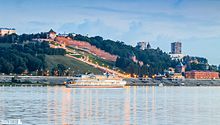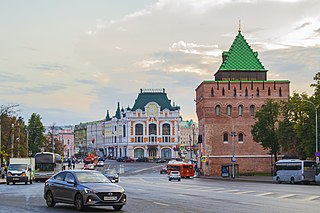
Nizhny Novgorod, colloquially shortened to Nizhny, from the 13th to the 17th century Novgorod of the Lower Land, known from 1932 to 1990 as Gorky, is the administrative centre of Nizhny Novgorod Oblast and the Volga Federal District in Russia. The city is located at the confluence of the Oka and the Volga rivers in Central Russia, with a population of over 1.2 million residents, up to roughly 1.7 million residents in the urban agglomeration. Nizhny Novgorod is the sixth-largest city in Russia, the second-most populous city on the Volga, as well as the Volga Federal District. It is an important economic, transportation, scientific, educational and cultural center in Russia and the vast Volga-Vyatka economic region, and is the main center of river tourism in Russia. In the historic part of the city there are many universities, theaters, museums and churches.

Nizhny Novgorod Oblast is a federal subject of Russia. Its administrative center is the city of Nizhny Novgorod. It has a population of 3,310,597 as of the 2010 Census. From 1932 to 1990 it was known as Gorky Oblast.

Valery Pavlovich Chkalov was a test pilot awarded the title Hero of the Soviet Union (1936).

The Nizhny Novgorod Metro, formerly known as the Gorky Metro, is a rapid-transit system which serves the city of Nizhny Novgorod, Russia. Opened in 1985, it consists of 15 stations and is 21.6 kilometres (13.4 mi) long. The metro connects with the City Rail and Nizhny Novgorod Central Diameters systems at the Moskovskaya station. It has the third-largest number of stations of any Russian subway system, the largest two being Moscow and St. Petersburg.

Chkalovsk is a town in Nizhny Novgorod Oblast, Russia, located on the right bank of the Volga River, 95 kilometers (59 mi) northwest of Nizhny Novgorod, the administrative center of the oblast. As of the 2010 Census, its population was 12,368.
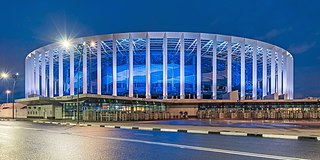
Nizhny Novgorod Stadium is a football stadium in Nizhny Novgorod, Russia. It was one of the venues for the 2018 FIFA World Cup. It has a capacity of 44,899 spectators.

Chkalovskaya is a station on the Avtozavodskaya line of the Nizhny Novgorod Metro. It opened on 20 November 1985 and was one of six initial stations of the Metro.

Moskovskaya is a station on both Line 1 and Line 2 line of the Nizhny Novgorod Metro. It was one of the first six stations to open on the line on 20 November 1985. It is also the only station that permits transfers from one line to the other. Passengers may also transfer to the main Nizhny Novgorod railway station. Also, the metro station Moskovskaya is a transfer hub to the station of the City Rail Nizhny Novgorod-Moskovsky.

Gorkovskaya is a station on the Nizhny Novgorod Metro and is the northern terminus on the Avtozavodskaya line. It opened on November 4, 2012. It is also the only station on the right bank of the Oka River in the historic Upper City section of Nizhny Novgorod. The station is named for Gorky Square, under which the station is situated. Maxim Gorky was born in Nizhny Novgorod and the city was itself named Gorky until 1990.

Nizhny Novgorod railway station is a central station in Nizhny Novgorod, Russia. In terms of the amount of work performed, the 1st class station, and by the nature of the work performed, is a cargo station. It was opened on August 2, 1862.

The Nizhny Novgorod tram network comprises 16 tramlines and uses a standard Russian broad gauge. Trams have been operating in Nizhny Novgorod since 1896, but services were interrupted for a few years following the 1917 Russian Revolution.

The Alexander Nevsky Cathedral is a Russian Orthodox cathedral church located in the Kanavinsky city district of Nizhny Novgorod. The cathedral is located on the former territory of the Nizhny Novgorod Fair. It is one of the unofficial symbols of Nizhny Novgorod, along with the Dmitrovskaya Tower of the Kremlin, the Chkalov staircase and the fair.

Rozhdestvenskaya Street – an historic street in Nizhny Novgorod. Is a unique open-air museum, there are only stone houses, the history of the oldest of which dates back to the middle of the 18th century. Officially there are 35 monuments of architecture. The most famous landmark is the Church of the Nativity.
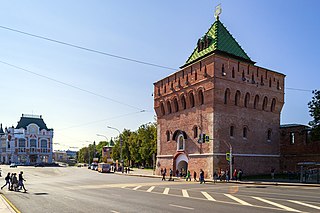
The Minin and Pozharsky Square, also known as just Minin Square, is the main square of Nizhny Novgorod. It is a social and cultural center of the city, the venue of the most important celebrations. It is located in the historical centre of the old town from the southeast side of the Kremlin.

Nizhny Novgorod was founded by Prince Yuri II of Vladimir in 4 February 1221. Citizens organized an army to liberate Moscow from the Poles in 1611, led by Kuzma Minin and Prince Dmitry Pozharsky. During the Russian Empire, in 1817 Nizhny Novgorod became the country's main trading city. In 1896, the city hosted the largest All-Russia exhibition. In the Soviet era, Nizhny Novgorod was renamed Gorky, in honor of the writer Maxim Gorky. Then it was the industrial center of the Soviet Union. During the World War II, the city sent to the front a huge amount of military equipment and ammunition. Therefore, the German air force bombed the city for 3 years. After the dissolution of the Soviet Union, the city was renamed back to Nizhny Novgorod. In Russia, the city became a political center and the capital of the Volga Federal District. Now the city is the center of information technology and develops tourism.

The Spit of Nizhny Novgorod is one of the main natural landmarks in the historical centre of Nizhny Novgorod. It is located at the confluence of the Oka and Volga rivers.
Mikhail Sergeevich Kuznetsov is a Russian state, public and scientific figure. He served as Deputy head of Nizhny Novgorod, and deputy of the City Duma of Nizhny Novgorod.

Vadim Nikolayevich Sorokin is a Russian businessman, mechanical engineer and inventor. He holds the posts of the president and the CEO of GAZ Group. He is not related to convicted fraudster and con artist Anna Sorokin, also known as "Anna Delvey."
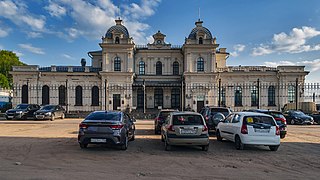
Romodanovsky railway station is a former railway station in Nizhny Novgorod. Construction of this station started in 1900 and was completed in 1904. The station was functional until 1974.
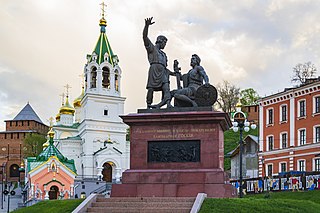
The Monument to Minin and Pozharsky is a copy of the monument erected on Red Square in Moscow. The monument is located in the historic centre of Nizhny Novgorod on National Unity Square, under the walls of the Kremlin, near the Church of St. John the Baptist.


